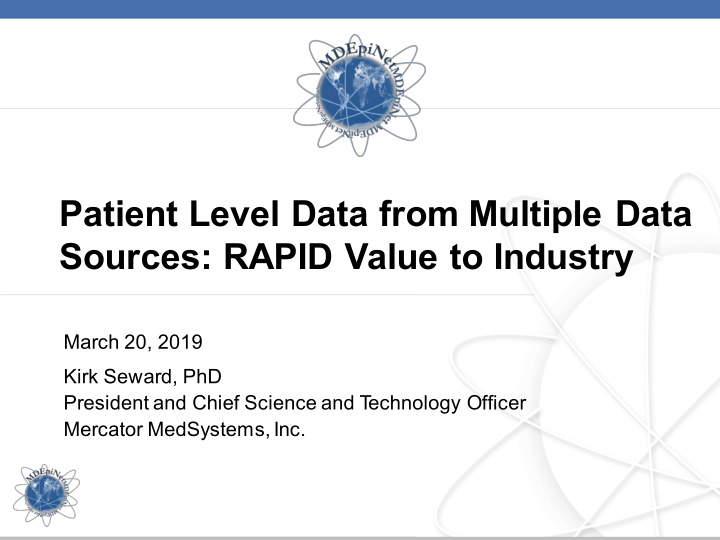



Patient Level Data from Multiple Data Sources: RAPID Value to Industry March 20, 2019 Kirk Seward, PhD President and Chief Science and T echnology Officer Mercator MedSystems, Inc.
Real World Evidence (RWE) • As a practical matter, RWE commonly guides clinical decision making In-Setting Availability Reimburse- ment ? Treatment Regulatory Guidance Decision Regulatory Guidance Clinical Evidence ? Treatment Clinical Evidence Decision Personal Experience ? Treatment Personal Experience Decision Treatment Decision
Sources of Real World Evidence • “Common practice” with straightforward, predictable outcomes • Published literature • Randomized, controlled trials (demographic information, but no patient-level data available; often not “real world” patient characteristics) • Open-label patient series (limited N) • Large experiential datasets (limited demographic information, no patient-level data available, but often more “real world”) • Registry databases (e.g. via RAPID initiative) • Patient-level data available • Able to predict an outcome based on selecting sets of patients to match certain eligibility criteria
Methods of Utilizing Real World Evidence • Objective Performance Goals/Criteria • PRO: Straightforward numeric target • CON: Quickly outdated • Propensity Matching • PRO: Able to proportionately match enrollment demographics and characteristics • CON: Must have thorough database with consistent primary endpoints; potentially expensive • Prospective Comparative Registry • PRO: Concurrent enrollment; consistent endpoints • CON: Not randomized; potential for treatment bias
Using Real World Evidence as Historical Controls with ICH E10 Guidance “[historically] controlled trials are most likely to be persuasive when… the study end point is objective, Need to use core laboratory adjudication and objective measurements to limit bias. when the outcome on treatment is markedly Robust (statistically significant) signal is key different from that of the external control and a high level of statistical significance for the treatment-control comparison is attained when the covariates influencing outcome of Similar eligibility criteria between subjects or the disease are well characterized, propensity matching. and when the control closely resembles the Large data set available for propensity study group in all known relevant baseline, matching with consistent endpoint. treatment (other than study drug), and observational variables”
Case Study: Mercator MedSystems
Comparing Patency Outcomes after Localized Drug Delivery in Fem/Pop Lesions Direct: Adventitial Delivery with Bullfrog Indirect: Luminal Delivery with DCB • Multi-site drug • Single-site delivery delivery per balloon • Needle reaches • Drug formulations directly into tailored to diffuse target tissues through vessel wall • Few limitations on what drugs • Limited to can be paclitaxel (so far) delivered • Extensive, • Clinical data in positive clinical development fem/pop data
The DANCE Trial Dexamethasone to the Adventitia to eNhance Clinical Efficacy in fem/pop disease Baseline angiogram and biomarker blood • Multicenter, open-label, historically controlled draw trial • SFA and Popliteal 159 ATX 124 PTA • Primary atherectomy (ATX) or primary angioplasty (PTA) based on investigator decision ADD-DEX Treatment • Adventitial drug delivery of dexamethasone (ADD-DEX) in all subjects • Primary Endpoints: Blood draws for change in • Safety: A composite of major adverse limb biomarkers (~1/3 of patients) at 24 events (MALE) and post operative death hours and 4 weeks (POD) within 30 days from the procedure • Efficacy: Primary patency at 12 months • Freedom from binary restenosis by duplex ultrasound Clinical, hemodynamic and duplex U/S (PSVR ≤ 2.4) or angiography and follow- up at 6, 12, 18, 24 months • Freedom from clinically-driven target lesion revascularization (CD-TLR)
Original Statistical Analysis: Comparison to Contemporary Published Results • Published outcomes: • Non-inferior benefit to a chemotherapeutic agent (paclitaxel) delivered by historical drug-coated balloons (DCB) • Superior benefit to historical percutaneous transluminal angioplasty (PTA) JACC Intervention 2018;11:921-31
Proposed Additional Examination of DANCE Data Utilizing RAPID • Identify registry database with patient-level data • Perform fit-for-purpose analysis against positive control and continue if passing • Analyze propensity-matched patency data to determine superiority of active treatment over historical controls from registry • Seek regulatory approval based on propensity-matched analysis • Launch post-market study utilizing active registry sites to gather patency data on active treatment and other treatment methods for purpose of further efficacy and safety comparisons
RAPID Value to Industry • Enhances ability to perform studies in real-world patients for comparison to registry data, improving rates of enrollment • In competitive landscape with new entries, novel therapies may encounter barriers to entry due to requirements of RCT enrollment • RAPID can provide an outcomes baseline that moves with innovation, to allow for both superiority and non-inferiority comparisons • Registry networks enable novel prospective trial designs and potential “turnkey” study methods • Use of registry networks enhances total product life cycle and post-market analysis of effectiveness • Open questions: • How does GUDID or AUDI incorporate decoupled drug/device combinations? • How can data from registries be interpreted (or misinterpreted) using analyses that are outside of device manufacturer’s control? • Will data be used for precision medicine or competitive behavior? • Interface with CMS – are there impacts regarding pay for performance? • What will be the effect on innovation?
Recommend
More recommend